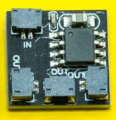Howdy all and thanks for the help in advance.
I thought I’d approach this topic from a reverse engineering angle! I’m trying to figure out how this tiny board that drives 3 discrete small flickering LEDs works.

I know you can buy small lights with flicker built in but I want to understand what’s under the hood so I can create small boards to hide in dioramas, etc. Thoughts / questions:
- Main controller chip? Research points me to Attiny chips but I’ve also come across a few other options. What are we seeing here, I wonder.
- Variation in the flicker? This depends on the code as well as the outputs on the chip, correct? This example has 3 outputs. I’m not a programmer but I can do simple sketches on the Arduino and I'm also open to other simple options.
I’ve done some low-level THT soldering on small boards with tiny lights (0402, 0603, 0805) and appropriate resistors for 5V, small connectors (JST ZH), etc. I’ve also created a simple power hub board in KiCad so I have an idea of the basics but I’m still a beginner.
Essentially, I’m eager to figure out something tiny, cheap, and not too crazy! Any ideas where to start?
I thought I’d approach this topic from a reverse engineering angle! I’m trying to figure out how this tiny board that drives 3 discrete small flickering LEDs works.

I know you can buy small lights with flicker built in but I want to understand what’s under the hood so I can create small boards to hide in dioramas, etc. Thoughts / questions:
- Main controller chip? Research points me to Attiny chips but I’ve also come across a few other options. What are we seeing here, I wonder.
- Variation in the flicker? This depends on the code as well as the outputs on the chip, correct? This example has 3 outputs. I’m not a programmer but I can do simple sketches on the Arduino and I'm also open to other simple options.
I’ve done some low-level THT soldering on small boards with tiny lights (0402, 0603, 0805) and appropriate resistors for 5V, small connectors (JST ZH), etc. I’ve also created a simple power hub board in KiCad so I have an idea of the basics but I’m still a beginner.
Essentially, I’m eager to figure out something tiny, cheap, and not too crazy! Any ideas where to start?






